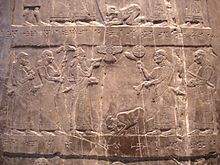Proskynesis


The term Proskynese ( ancient Greek προσκύνησις proskýnēsis "kiss towards something"), or Adōrātĭo ( Latinized : adoratio ) denotes the gesture of worship , devotion and submission practiced especially in the realms of the ancient Orient .
Proskynesis usually consisted of the subject throwing himself at the ruler's feet, i.e. at least kneeling and bowing his head to the floor, sometimes lying face down on the floor ( prostration ). He put his hand or finger on the mouth to kiss and then stretched it out in the direction of the god or ruler to be worshiped. Proskynesis is a well-known cultic gesture in the Bible .
Proskynesis is often used as a synonym for " footfall " in research, but this equation is problematic, at least for the early days: There are many indications that "Proskynesis" was by no means always associated with footfall, but that this honorary testimony in the ancient Orient as well could be done in the form of a brief bow and a kiss in the air. Many scholars today believe that the footfall was initially only required by certain groups of people.
history
Proskynesis was widespread in the ancient Persian Empire . Mordechai's refusal to prosecynesis before Haman , a minister of King Ahasuerus , is one of the central themes in the Book of Esther in the Old Testament of the Bible. Alexander the Great is said to have adopted or tolerated this custom from Persia and in the spring of 327 tried in vain to make it a mandatory element of the court ceremony. In doing so, he adopted the Persian custom of paying homage not only to the gods, but also to the great king (not regarded as god) in this way (according to Arrian , he did this explicitly with the intention of claiming divine honors). Alexander's Greek and Macedonian soldiers seem to have irritated this gesture: In classical Greece and in Rome it was unusual towards people until it was introduced (at the latest) under Emperor Diocletian as adoratio purpurae ("adoration of the [imperial] purple"). In the Eastern Roman and Byzantine empires , Proskynesis was part of the common court ceremonies; since Justinian I at the latest, a regular footfall ( prostratio ) was definitely meant.

In Orthodox and Catholic theology , Proskynesis describes the simple veneration that one may also give to saints , icons, etc., in contrast to Latreia (worship), which is only due to the Triune God .
In the Catholic Church , which adopted many elements of the late antique court ceremonies, the Proskynesis has been preserved as prostration among other things in the Good Friday liturgy and in the liturgy of priestly ordination . At the beginning of the Good Friday liturgy, the priest and the concelebrants prostrate themselves in front of the completely empty altar . In the same way, ordination candidates do this during the All Saints litany of their ordination service.
In the Eastern Churches , Proskynesis is the name of one of the three great feasts of the cross.
Proskynesis still lives on today in the Muslim ruku , the bowing with the upper body during prayer .
literature
- Stefanos Alexopoulos: Proskynesis. In: Real Lexicon for Antiquity and Christianity . Volume 28, Hiersemann, Stuttgart 2018, ISBN 978-3-7772-1815-1 , Sp. 360–372
- Berthe M. Marti: Proskynesis and Adorare. In: Language. Vol. 12, No. 4, 1936, ISSN 0097-8507 , pp. 272-282, doi : 10.2307 / 409153 .
- Otto Seeck : Adoratio . In: Paulys Realencyclopadie der classischen Antiquity Science (RE). Volume I, 1, Stuttgart 1893, column 400 f.
- Günter Weiß: Proskynesis. In: Lexicon of the Middle Ages . Volume 7: Planudes to City (Rus'). Artemis-Verlag et al., Munich 1995, ISBN 3-7608-8907-7 , Sp. 265-266.
- Josef Wiesehöfer : Proskynesis. In: The New Pauly (DNP). Volume 10, Metzler, Stuttgart 2001, ISBN 3-476-01480-0 , column 443 f.
- Josef Wiesehöfer: "Because you do not pay homage to a person as your ruler, but only to the gods". Notes on Proskynesis in Iran. In: Carlo Cereti, Mauro Maggi, Elio Provasi (Eds.): Religious Themes and Texts of Pre-Islamic Iran and Central Asia. Studies in Honor of Professor Gherardo Gnoli on the occasion of his 65th birthday on 6th December 2002 (= Contributions to Iranian Studies. Vol. 24). Reichert, Wiesbaden 2003, ISBN 3-89500-329-8 , pp. 447-452.
Web links
- Jonah Lendering: Proskynesis . In: Livius.org (English)
- Thomas Staubli : Proskynesis. In: www.bibelwissenschaft.de.
Individual evidence
- ↑ The Oxford Dictionary of Byzantium: in 3 vol. / ed. by Dr. Alexander Kazhdan . - NY; Oxford: Oxford University Press, 1991. - 2232 p. - ISBN 0-19-504652-8 . - Third volume, P. 1738
- ^ Friedrich Lübker (1860). Real dictionary of classical antiquity for grammar schools . Leipzig: Teubner./ p. 10.